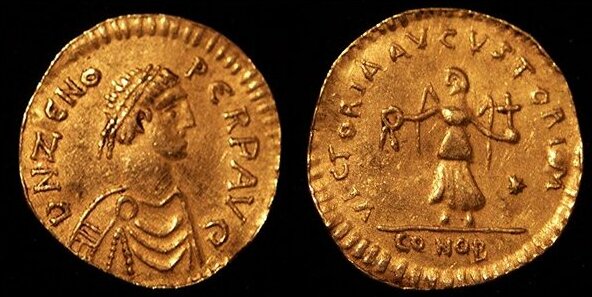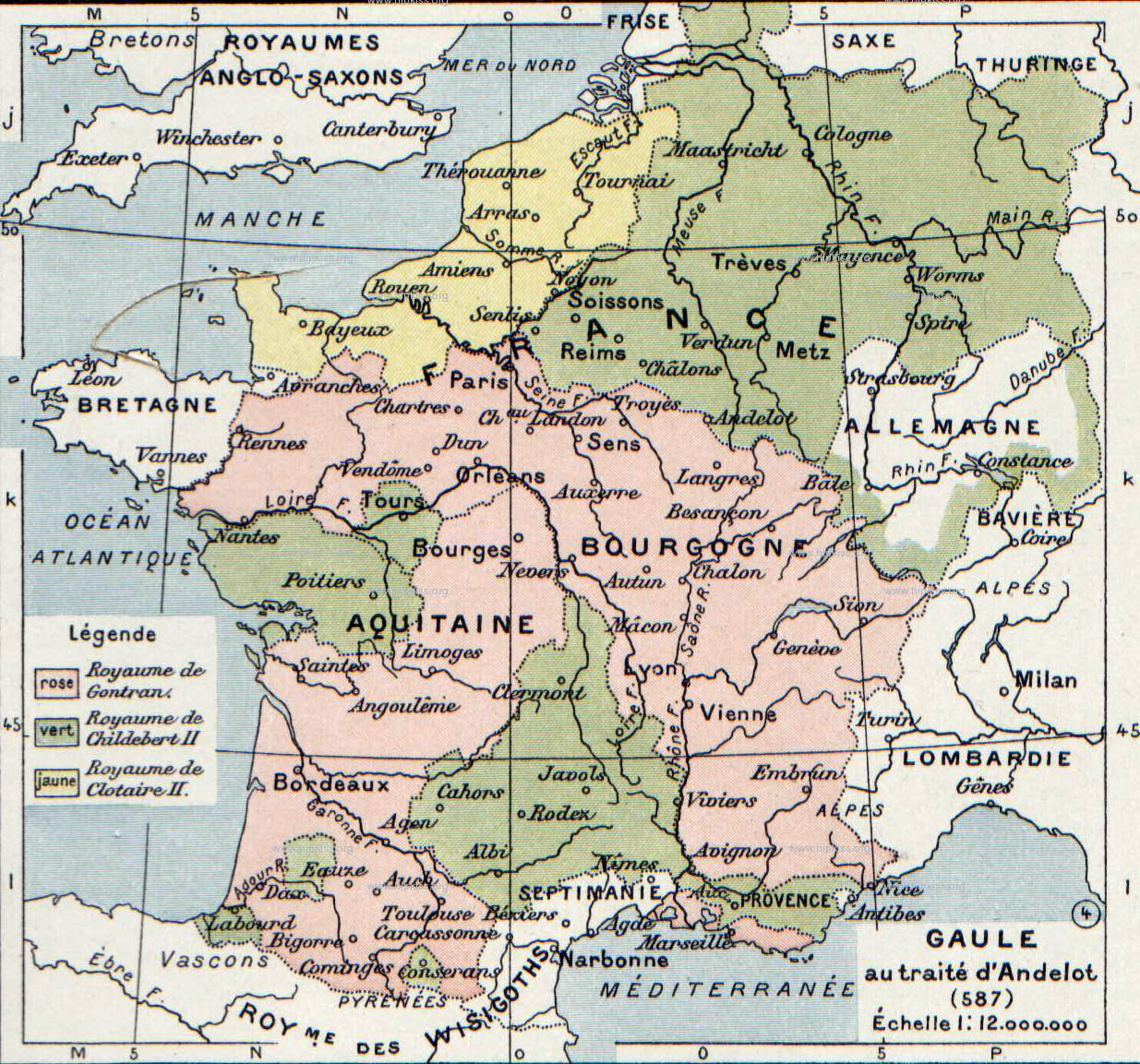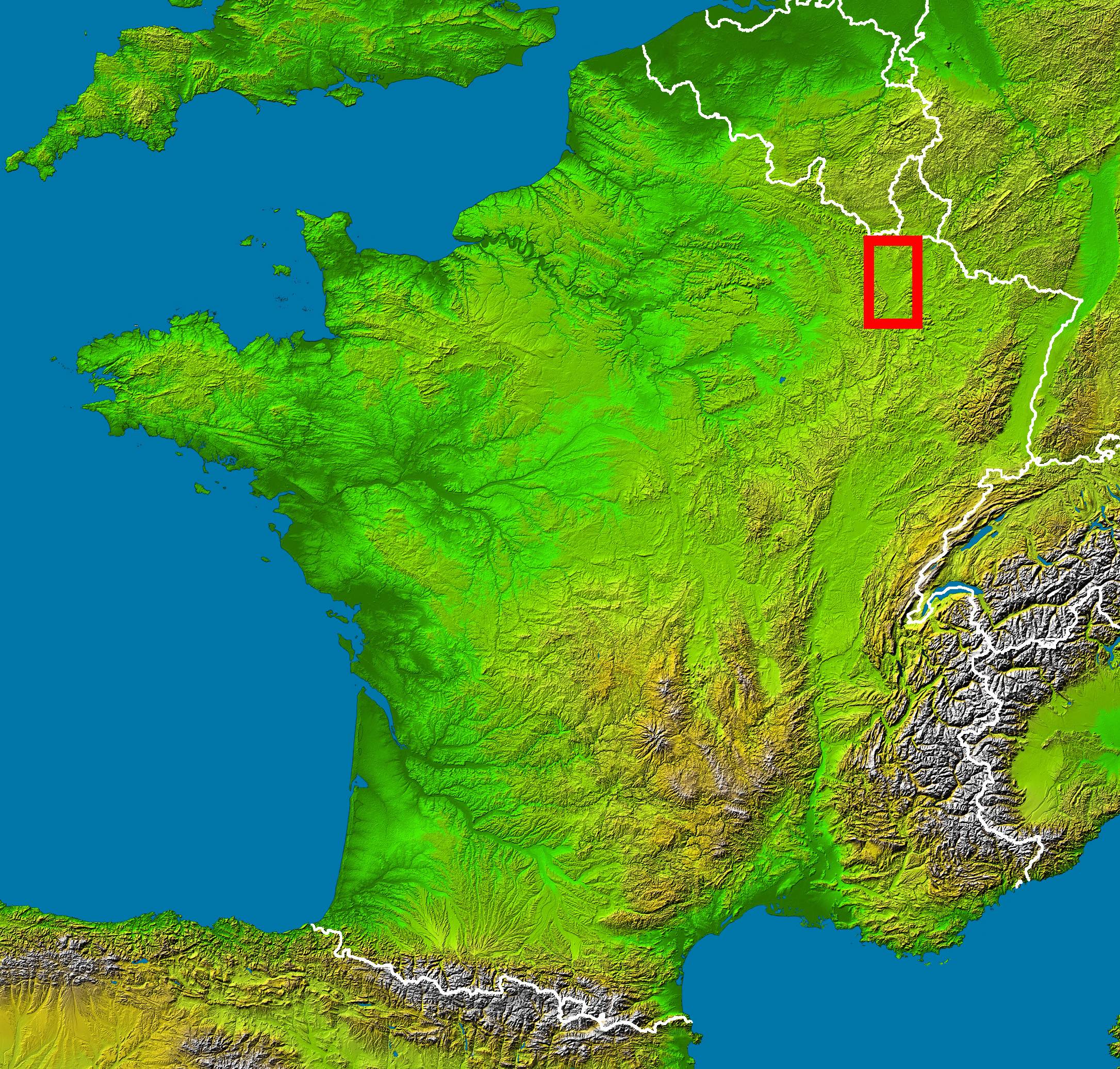|
Childebert II
Childebert II (c.570–596) was the Merovingian king of Austrasia (which included Provence at the time) from 575 until his death in March 596, as the only son of Sigebert I and Brunhilda of Austrasia; and the king of Burgundy from 592 to his death, as the adopted son of his uncle Guntram. Childhood When his father was assassinated in 575 by two slaves of Queen-consort Fredegund of Soissons,Van Dam. Raymond. "Merovingian Gaul and the Frankish conquests", ''The New Cambridge Medieval History: Volume 1, c. 500–c. 700'', ed. Paul Fouracre, Rosamond Mac Kitterick, (Cambridge University Press, 2005), 204. Childebert was taken from Paris by Gundobald (according to one story, after being lowered from a window in a bag by his mother), one of his faithful lords, to Metz (the Austrasian capital), where he was recognized as sovereign. He was then only five years old, and during his long minority the power was disputed between his mother Brunhilda and the nobles, with Brunhilda being dom ... [...More Info...] [...Related Items...] OR: [Wikipedia] [Google] [Baidu] |
Tremissis
The tremissis or tremis (Greek: τριμίσιον, ''trimision'') was a small solid gold coin of Late Antiquity. Its name, meaning "a third of a unit", formed by analogy with semissis (half of a unit), indicated its value relative to the solidus. It was introduced into Roman currency in the 380s by the Emperor Theodosius I and initially weighed 8 siliquae (equivalent to 1.52 grams).Philip Grierson, "Tremissis", in Alexander Kazhdan, ed., ''The Oxford Dictionary of Byzantium'' (Oxford University Press, 1991 nline 2005, vol. 3, p. 2113. Roman tremisses continued to be commonly minted into the reign of Leo III (717–741), but thereafter they were only rarely struck in the east of the empire, probably only for ceremonial uses, until the reign of Basil I (867–886), after which they disappeared. Nevertheless, the coin continued in common use in the Sicilian theme until the fall of Syracuse in 878. The trachy, introduced in the 11th century, was equivalent in value to the old ... [...More Info...] [...Related Items...] OR: [Wikipedia] [Google] [Baidu] |
Gregory Of Tours
Gregory of Tours (30 November 538 – 17 November 594 AD) was a Gallo-Roman historian and Bishop of Tours, which made him a leading prelate of the area that had been previously referred to as Gaul by the Romans. He was born Georgius Florentius and later added the name Gregorius in honour of his maternal great-grandfather. He is the primary contemporary source for Merovingian history. His most notable work was his ''Decem Libri Historiarum'' (''Ten Books of Histories''), better known as the ''Historia Francorum'' (''History of the Franks''), a title that later chroniclers gave to it. He is also known for his accounts of the miracles of saints, especially four books of the miracles of Martin of Tours. St. Martin's tomb was a major pilgrimage destination in the 6th century, and St. Gregory's writings had the practical effect of promoting highly organized devotion. Biography Gregory was born in Clermont, in the Auvergne region of central Gaul. He was born into the upper stratum ... [...More Info...] [...Related Items...] OR: [Wikipedia] [Google] [Baidu] |
Clotaire II
Chlothar II, sometime called "the Young" ( French: le Jeune), (May/June 584 – 18 October 629), was king of Neustria and king of the Franks, and the son of Chilperic I and his third wife, Fredegund. He started his reign as an infant under the regency of his mother, who was in an uneasy alliance with Chlothar's uncle King Guntram of Burgundy, who died in 592. Chlothar took power upon the death of his mother in 597; though rich, Neustria was one of the smallest portions of Francia. He continued his mother's feud with Queen Brunhilda with equal viciousness and bloodshed, finally achieving her execution in an especially brutal manner in 613, after winning the battle that enabled Chlothar to unite Francia under his rule. Like his father, he built up his territories by seizing lands after the deaths of other kings. His reign was long by contemporary standards, but saw the continuing erosion of royal power to the French nobility and the church against a backdrop of feuding among the ... [...More Info...] [...Related Items...] OR: [Wikipedia] [Google] [Baidu] |
Woëvre
The Woëvre () (German: ''Waberland'') is a natural region of Lorraine in northeastern France. It forms part of Lorraine plateau and lies largely in the department of Meuse. Along with the Côtes de Moselle, the Woëvre is one of the areas in Lorraine that receives the least rainfall; nonetheless, its river system is very important and feeds into the Lac de Madine. Location It lies on the right bank of the river Meuse, from the valley of the Chiers in the north to the town of Neufchâteau in the south. To the west, the region follows the Meuse, and to the east, it extends into the neighboring department of Meurthe-et-Moselle. The Lac de Madine lies in the Woëvre, like does the western part of the Parc naturel régional de Lorraine. Neighboring natural regions include the Côtes de Meuse on the left bank of the Meuse, the Barrois to the south and the Côtes de Moselle to the east. The part French, part Belgian Gaume region lies to the north. Features Since the Middle A ... [...More Info...] [...Related Items...] OR: [Wikipedia] [Google] [Baidu] |
Treaty Of Andelot
The Treaty of Andelot (or Pact of Andelot) was signed at Andelot-Blancheville in 587 between King Guntram of Burgundy and Queen Brunhilda of Austrasia. Based on the terms of the accord, Brunhilda agreed that Guntram adopt her son Childebert II as his successor and ally himself with Childebert against the revolted '' leudes''. Gregory of Tours wrote in his ''Historia Francorum'' that in the thirteenth year of Childebert, he went on an embassy for the king from Metz to Chalon to meet Guntram, who alleged that prior promises were being broken, especially concerning the division of Senlis. Significantly to Gregory, the treaty brought about the cession of Tours by Guntram to Childebert. An agreement was provided in writing and Gregory preserves the text of the treaty in his history. See also *List of treaties *Burgundy *Neustria *Austrasia Austrasia was a territory which formed the north-eastern section of the Merovingian Kingdom of the Franks during the 6th to 8th centuries. It ... [...More Info...] [...Related Items...] OR: [Wikipedia] [Google] [Baidu] |
Gundoald
Gundoald or Gundovald was a Merovingian usurper king in the area of southern Gaul in either 584 or 585. He claimed to be an illegitimate son of Chlothar I and, with the financial support of the Emperor Maurice, took some major cities in southern Gaul, such as Poitiers and Toulouse, which belonged to Guntram, king of Burgundy, a legitimate son of Chlothar I. Guntram marched against him, calling him nothing more than a miller's son and named him 'Ballomer'. Gundovald fled to Comminges and Guntram's army set down to besiege the citadel (now known as Saint-Bertrand-de-Comminges). The siege was successful, Gundovald's support drained away quickly and he was handed over by the besieged to be executed. The sole source for Gundovald is Gregory of Tours, who wrote about the events in his 'Histories', books 6 and 7. Gundovald was never king of Aquitaine as is sometimes thought; there was no such separate kingdom at the time. While his main backers were magnates of Austrasia, the Byzanti ... [...More Info...] [...Related Items...] OR: [Wikipedia] [Google] [Baidu] |
Nicetius Of Provence
Nicetius, or Nicetas, was the Count of Clermont, Duke of Auvergne, and Governor of Provence in the late sixth century. He sent gifts to Childebert II in order to secure a dukedom. He received, as constituting his duchy, the cities of Rodez, Clermont, and Uzès. According to Gregory of Tours, though he was young at the time, he was "a man of acute insight," who "established peace in the Auvergne." In 585, he participated in a war against the Visigoths; Gregory strongly criticises his conduct in the war ("crime and deception"). Afterwards, he patrolled the border between Septimania (the Gothic province of Narbonensis) and his own Frankish territory, the so-called "Dukedom of Auvergne." In 587, he was made governor of Provence (the diocesan province of Marseille) as well. In 588 Theodore, Bishop of Marseille, complained to the king that there had been a plague in Provence. Nicetius was replaced in the countship of Clermont by one Eulalius. Sources *Gregory of Tours Gregory ... [...More Info...] [...Related Items...] OR: [Wikipedia] [Google] [Baidu] |
Domesticus (Roman Empire)
The origins of the word ''domesticus'' can be traced to the late 3rd century of the Late Roman army. They often held high ranks in various fields, whether it was the servants of a noble house on the civilian side, or a high-ranking military position. After serving under the emperor for a certain duration, the Domestici would be able to become leaders themselves and potentially command their own regiment of legionaries in the military. Relatively, the most important offices were the “Comes Domesticorum” also known as, “Commander of the Protectores Domestici,” and “Comes rei Militaris” or General. Origin The domestici rose to prominence during the Crisis of the 3rd Century, the myriad of societal catastrophes nearly led to the collapse of the Roman Empire. The accession of Diocletian and his subsequent reforms ended the continual strife and unstable leadership Ancient Rome had faced during this period. The title of “Domesticus” was developed to advocate for bett ... [...More Info...] [...Related Items...] OR: [Wikipedia] [Google] [Baidu] |
Theodore, Bishop Of Marseille
Theodore ( la, Theodorus) was the bishop of Marseille from at least 566 until 591/594. In the 580s, Theodore was at the centre of a dispute over the city of Marseille between King Guntram and his nephew, King Childebert II. He was arrested several times. His troubles are recorded by the contemporary historian Gregory of Tours, who depicts him as a saintly albeit powerless figure who was supported by the laity, but opposed by his own clergy. Venantius Fortunatus, in a poem of 566, asks Dynamius of Marseille to greet his bishop, Theodore, and his metropolitan, of Arles. The city of Marseille was at the time the most important Mediterranean port in Merovingian Francia. In 581, while he was on his way to Childebert's court, Theodore was arrested by Dynamius, then governor of Provence. The former governor, Jovinus, was arrested at the same time. The clergy of Marseille, immediately acted as if he was dead. The charges against him, which are unknown, were eventually dropped and h ... [...More Info...] [...Related Items...] OR: [Wikipedia] [Google] [Baidu] |
Jovinus Of Provence
Jovinus or Jovin was the Governor of Provence from 570 until he was replaced by Sigebert I with Albinus in 573. He was a famous and cultured man and he maintained a brief correspondence with the poet Venantius Fortunatus. Testimony He testified against Albinus in court when the latter was charged with imprisoning an archdeacon unlawfully on Christmas Day. Albinus was later replaced by Dynamius and elected to the Diocese of Uzès. When he died, Jovinus was elected bishop in his place. Guntram of Burgundy later had Jovinus arrested as he travelled with Theodore, Bishop of Marseille, to meet Childebert II, because Guntram was then in rivalry concerning the diocese of Marseille. In alliance with Guntram, Dynamius instigated the election of rival candidate in the person of the deacon Marcellus, son of the senator Felix. Marcellus made war on Jovinus but eventually just bought him off. Sources *Gregory of Tours Gregory of Tours (30 November 538 – 17 November 594 AD) was a G ... [...More Info...] [...Related Items...] OR: [Wikipedia] [Google] [Baidu] |
Diocese Of Uzès
In church governance, a diocese or bishopric is the ecclesiastical district under the jurisdiction of a bishop. History In the later organization of the Roman Empire, the increasingly subdivided provinces were administratively associated in a larger unit, the diocese (Latin ''dioecesis'', from the Greek term διοίκησις, meaning "administration"). Christianity was given legal status in 313 with the Edict of Milan. Churches began to organize themselves into dioceses based on the civil dioceses, not on the larger regional imperial districts. These dioceses were often smaller than the provinces. Christianity was declared the Empire's official religion by Theodosius I in 380. Constantine I in 318 gave litigants the right to have court cases transferred from the civil courts to the bishops. This situation must have hardly survived Julian, 361–363. Episcopal courts are not heard of again in the East until 398 and in the West in 408. The quality of these courts was ... [...More Info...] [...Related Items...] OR: [Wikipedia] [Google] [Baidu] |
Dynamius Of Provence
Dynamius or Dinamius was the Rector of Provence (''rector Provinciae'') from 575, when he replaced Albinus. At the time, Provence and Austrasia lay within the kingdom of Childebert II, though half of Marseille, the chief Provençal city, was under the lordship of Guntram, King of Burgundy. Dynamius and Guntram allied together for their own mutual benefit at the expense of Childebert. Dynamius instigated the canons of the Diocese of Uzès to elect their deacon Marcellus, son of the senator Felix, as bishop in opposition to their already-elected bishop Jovinus, a former governor of Provence. While Jovinus and Theodore, Bishop of Marseille, were travelling to the court of Childebert II, Guntram had them arrested. Dynamius, meanwhile, blocked Gundulf, a duke of an important senatorial family and Childebert's former '' domesticus'', from entering Marseille on behalf of Childebert. Eventually he was forced to yield, though he later arrested Theodore again and had him sent to Guntram. D ... [...More Info...] [...Related Items...] OR: [Wikipedia] [Google] [Baidu] |






